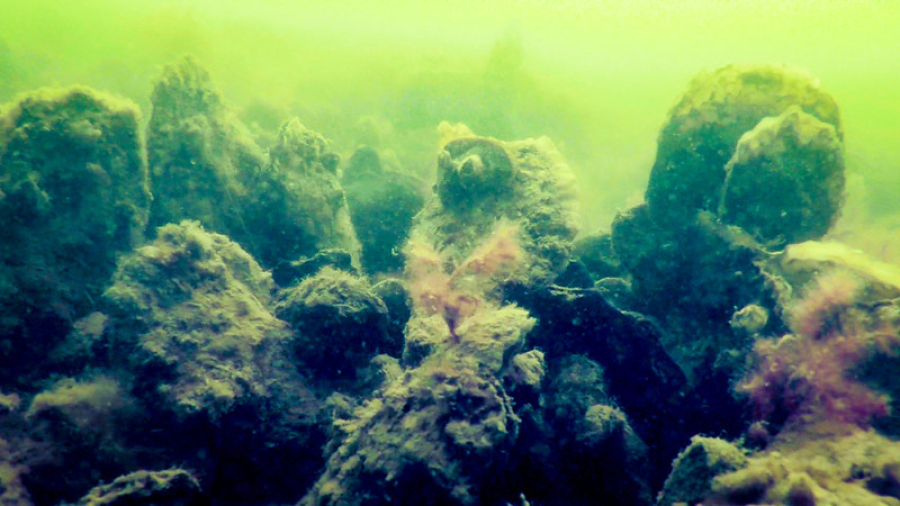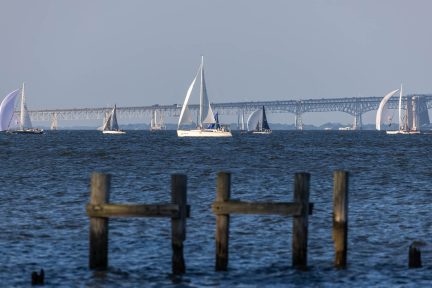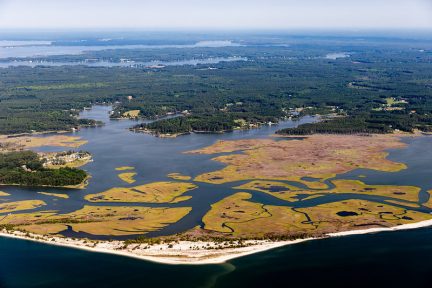Chesapeake Bay oyster reef restoration on track to meet 2025 goals
Eight out of 10 large-scale oyster reef restoration sites are now complete

The Chesapeake Bay Program announced today that efforts to restore healthy oyster reefs in 10 Chesapeake Bay tributaries by 2025 are on track to be achieved. In the 2014 Chesapeake Bay Watershed Agreement, Chesapeake Bay Program partners, including the National Oceanic and Atmospheric Administration (NOAA), U.S. Army Corps of Engineers, Maryland Department of Natural Resources (MD DNR), Virginia Marine Resources Commission (VRMC), as well as several nonprofit organizations and academic institutions, committed to restore native oyster habitat and populations in 10 tributaries by 2025 and ensure their protection.
Currently, eight of the 10 original tributaries selected for large-scale restoration are considered to be complete. The remaining two–the Manokin River in Maryland and the Lynnhaven River in Virginia–have 222 and 38 more acres to go, respectively. As of the end of 2023, 1,572 acres of oyster reefs have been restored across the Chesapeake Bay, which is equal to 2,075 football fields.
After each tributary was selected for restoration, scientists developed a strategy to guide the process of constructing and seeding reefs, as well as monitoring and evaluating their progress. Monitoring and evaluation take place at three-and-six-year intervals, which will continue beyond 2025. These activities are critical to determine the overall success of the restoration by tracking the recruitment of new oysters, how many survived in the early stages of planting, natural mortality, disease status, growth, reproduction and shell accumulation.
The monitoring and evaluation phase is underway for the following tributaries: Little Choptank (Md.), Tred Avon (Md.), upper St. Mary’s (Md.), Piankatank (Va.), lower York (Va.), Lafayette (Va.) and Great Wicomico (Va.). Large-scale oyster restoration in Harris Creek (Md.) is considered to be achieved as its monitoring and evaluation phase has been completed.
In April 2024, the lower York River in Virginia was celebrated as the eighth oyster restoration site to be completed. More than 200 acres of reef was constructed as part of this project.
Facts
Large-scale oyster restoration in the Chesapeake Bay is an internationally recognized success story. Since 2014, Chesapeake Bay Program partners have spent approximately $108 million to construct reefs (note: this figure does not include activities related to monitoring or evaluation). The 2023 Chesapeake Bay Oyster Restoration Update shows the following updates for each tributary:
| Tributary | Tributary Restoration Plan | Reef Construction and Seeding | Monitoring and Evaluation | Completed/Target Acreage (including pre-existing healthy reef acreage) |
|---|---|---|---|---|
| Harris Creek (Md.) | Complete | Complete | Complete | 343/343 |
| Little Choptank (Md.) | Complete | Complete | In Progress | 358/358 |
| Tred Avon (Md.) | Complete | Complete | In Progress | 130/130 |
| Upper St Mary’s (Md.) | Complete | Complete | In Progress | 60/60 |
| Manokin (Md.) | Complete | In Progress | In Progress | 219/441 |
| Lafayette (Va.) | Complete | Complete | In Progress | 82/82 |
| Piankatank (Va.) | Complete | Complete | In Progress | 497/444 |
| Lynnhaven (Va.) | Complete | In Progress | In Progress | 114/152 |
| Lower York (Va.) | Complete | Complete | In Progress | 204/200 |
| Great Wicomico (Va.) | Complete | Complete | In Progress | 124/124 |
| Eastern Branch* of the Elizabeth River (Va.) | N/A | Complete | In Progress | 24/20 |
*The Eastern Branch of the Elizabeth River is an 11th “bonus” tributary established by Virginia in 2019.
Issues
Disease, historical overharvesting, poor water quality and habitat loss led to a severe drop in oyster populations over the last century. Excess nitrogen and phosphorus in the water can fuel the growth of algae blooms that create low-oxygen “dead zones” that can kill oysters or hinder their development. Stress related to poor water quality can make oysters more susceptible to disease and impact reproduction. Additionally, as clean shells are vital habitat for oysters, any sediment that covers it has the potential to cause suffocation.
Importance
Oysters are ecologically valuable as filter feeders that help clean the waters of the Chesapeake Bay and its tidal tributaries by pumping water through their gills and trapping food particles, nitrogen, phosphorus, sediment and chemical contaminants. Under certain conditions, an adult oyster can filter up to 50 gallons of water per day. In some situations, they can protect shorelines from wave erosion, helping communities to prepare for some of the disruptions that climate change can cause.
Oyster restoration at the tributary level aims to increase oyster populations to provide the ecosystem services that oyster reefs perform, including water quality improvements and habitat for aquatic critters. Recent research estimates that mature restored oyster reefs in the Choptank River watershed left unharvested for 10 years can contribute a 160% increase in blue crab harvests per year–supporting an additional 300 jobs.
Since the late 19th century, the oyster industry—including the catch, sale, shucking, packing and shipping of oysters—has contributed hundreds of millions of dollars to the region’s economy. Restoring oyster reefs in sanctuary areas can help support harvest reefs in nearby areas because oyster larvae from restoration reefs float with the current and can settle on those harvest reefs.
Quotes
“Tributary-scale oyster restoration in the Chesapeake Bay shows how states and the federal government can work together to bring about major environmental improvements. The Bay’s oyster restoration efforts have coincided with favorable environmental conditions in the Bay region that has led to an increase in Maryland oyster reproduction in recent years and growing oyster harvests for watermen in the state. The future for eastern oysters in the Chesapeake Bay is brighter than it has been for decades and there’s no question that the tributary-scale restoration efforts have played an important role in improving the outlook for these iconic Bay bivalves.”
- Josh Kurtz, Chair, Chesapeake Bay Program Principals’ Staff Committee and Secretary, Department of Natural Resources, State of Maryland
"I am immensely proud of the partnership between the Virginia Marine Resources Commission Shellfish Management Division and the NOAA Chesapeake Bay Office for their crucial role in advancing oyster restoration across these five Chesapeake Bay tributaries, most recently in the successful completion of the Lower York River Oyster Restoration project. This milestone not only fortifies Virginia's vital commercial fishery but also sets a national standard for sustainable coastal conservation. Our success with the largest alternative substrate planting project of the year showcases our dedication to science-driven management and public-private partnerships, significantly enhancing both our ecosystem and economy."
- Jamie L. Green, Commissioner, Virginia Marine Resources Commission
"It's exciting to see the progress that has been made toward the goal to restore oyster reef habitat in 10 Chesapeake tributaries by 2025. All this work is possible thanks to the strong partnership of federal and state agencies, local governments, nonprofit organizations and academic institutions who are committed to restoring the tremendous ecosystem and economic benefits that healthy oyster reefs provide.”
- Kevin Schabow, Acting Director, Chesapeake Bay Office, National Oceanic and Atmospheric Administration



